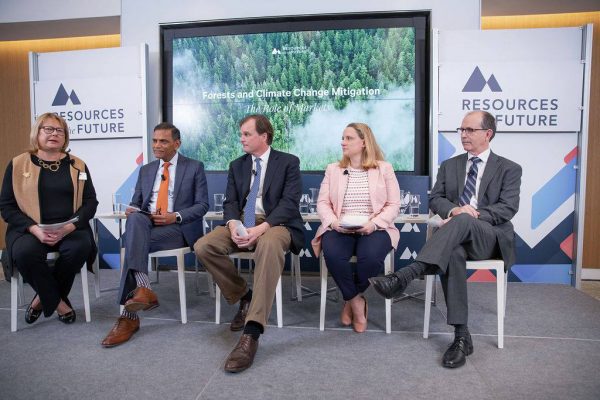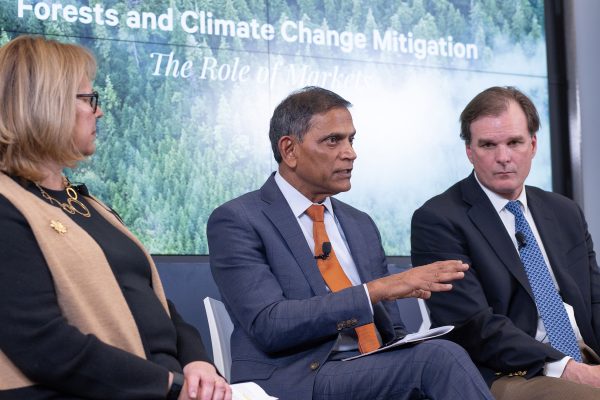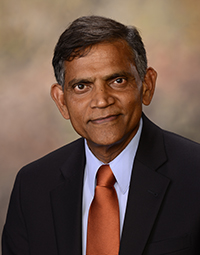Auburn University School of Forestry and Wildlife Sciences Dean Janaki Alavalapati recently joined a group of expert panelists to participate in the Resources for the Future live series event, Forests and Climate Change Mitigation: The Role of Markets, in Washington, D.C.
Hosted by Resources for the Future, or RFF, the event offered the opportunity for experts to engage in a discussion about the important role that forests—and the forest products sector—can play in climate change mitigation. There were 135 attendees and 186 others who joined the international discussion via livestream.
The in-depth conversation examined how a healthy forest products sector is critical in this regard, as it encourages the retention and management of forests.
Panelists included representatives from the forest industry and experts in forest science and policy. Serving with Alavapati were panelists Robert Bonnie, a research scholar at Duke University’s Nicholas Institute for Environmental Policy Solutions; RFF nonresident senior fellow David Wear; and Kate Gatto of the National Alliance of Forest Owners. Ann Bartuska, an RFF senior advisor, moderated the discussion, followed by a question-and-answer session between panelists and attendees.
The event began with a short background presentation on forest management and forest products from Wear. To show how forest markets interact with the carbon sink in the U.S., he pointed out that in the southeastern United States alone, since 1952 to the present, forest biomass has grown by more than 100 percent—from roughly 2 million acres of planted forests in 1952 to about 48 million acres today.
Wear emphasized this enormous growth came in response to marketing incentives. In short, forest products markets build the forest carbon sink with incentives to retain and add forests and expand productivity, revenues for forest fuel reductions and carbon storage and emission offsets.
Forests in the U.S. store the equivalent of 52 years’ worth of carbon emissions, and, while this reservoir continues to expand by about 0.5 percent each year, it is predicted that net growth will decline in the next 30 years, mostly due to land use changes and aging forests.
Setting off the panel discussion, Bartuska pointed out that while experts, stakeholders and policymakers have known about the tremendous role of forests in climate change mitigation for more than 20 years, only recently have we seen a rapid acceleration in attention to forests as a mitigation strategy. Her question was, “Why now?”
In response, Alavalapati explained that science-based information about forests’ role in climate mitigation is overwhelming and robust, in numerous areas including the carbon sequestration potential of forests, the carbon storage potential of wood products and displacing fossil fuels with sustainable, forest-based bioenergy. He also pointed to the overwhelming societal awareness of the benefits of carbon from forests—which is higher than ever before—and the growing number of people who are embracing the wise use of forest products and moving away from a pure preservation approach.
Alavalapati added that forest professionals have successfully moved the topic of the role of forests in climate mitigation to the front-and-center.
On this topic, Bonnie emphasized that this issue is “fundamentally a question of math.”
“There’s an increasing understanding that we need to dramatically reduce greenhouse gas emissions,” he said, “[but] for the whole of the U.S. economy, it’s very hard to make that math work…math is making a lot of folks think about not just the emissions side, but the sequestration side, as well.”
Bonnie also emphasized the “political math” needed in a country where there is still skepticism around climate sciences, particularly in rural constituencies. He urged the importance of engaging rural America in the climate change conversation, as well as questions about the ways that investment in forestry and agriculture can improve the economics of land usage while also maintaining the forest sink.
“If you think about the math of where the stakeholders and votes come from…rural matters, so these issues of markets are critically important.”
Gatto agreed, adding, “I think constituents are demanding from their elected officials to do something about climate.” Gatto said elected officials, in turn, see a lot of political opportunity in taking action regarding working forests in particular.
“There’s a lot of potential that forests bring to the table, whether you’re looking at the actual math, the political math or the constituent math,” she said. “There’s a lot of momentum that’s coming together here at the same time.”
The entire conversation can be viewed at https://www.rff.org/events/rff-live/forests-and-climate-change-mitigation-role-markets/
Alavalapati said the participants, as well as the hundreds who were either present or tuned into the discussion, took away some eye-opening views on this crucial topic, which can only be examined and ideally implemented through more in-depth discussions.
(Written by Teri Greene)












